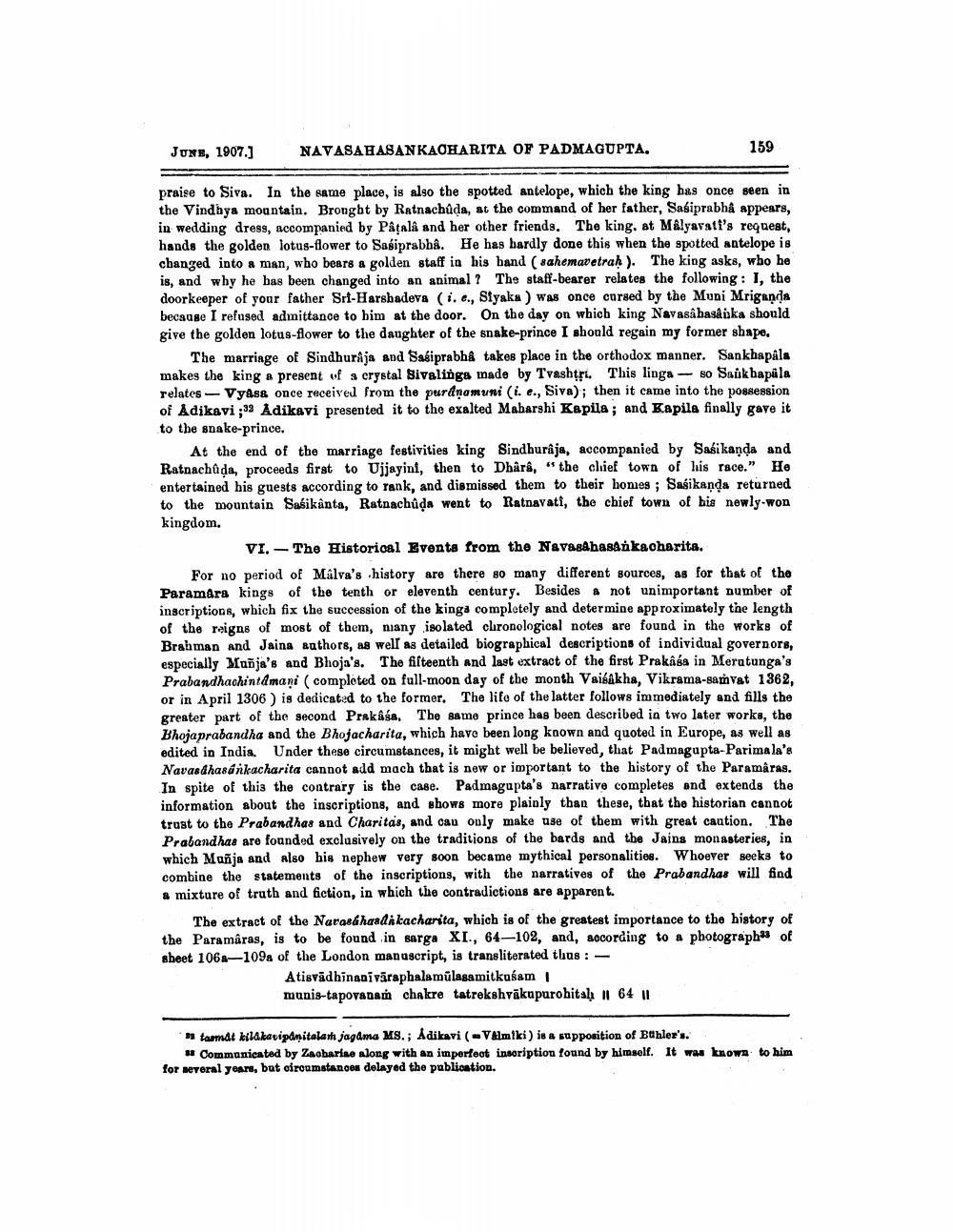________________
June, 1907.)
NAVASAHASANKACHARITA OF PADMAGUPTA.
159
praise to Siva. In the same place, is also the spotted antelope, which the king has once seen in the Vindhya mountain. Brought by Ratnachůda, at the command of her father, Sasiprabhå appears, in wedding dress, accompanied by Påtalâ and her other friends. The king, at MAlyavatt's request, hands the golden lotus-flower to Sabiprabha. He has hardly done this when the spotted antelope is changed into a man, who bears a golden staff in his band ( sahemavetrah). The king asks, who he is, and why he bas been changed into an animal ? The staff-bearer relates the following: 1, the doorkeeper of your father Sri-Harsbadeva (i. e., Siyaka ) was once cursed by the Muni Mriganda because I refused admittance to him at the door. On the day on which king Navasábasköka should give the golden lotus flower to the daughter of the snake-prince I should regain my former shape,
The marriage of Sindhuraja and Sabiprabhê takes place in the orthodox manner. Sankhapala makes the king a present of a crystal Sivalings nade by Tvashtri. This linga - 50 Sauk hapala relates - Vyåss once received from the purdnomuni (i. e., Siva); then it came into the possession of Adikavi ;33 Adikavi presented it to the exalted Maharshi Kapila ; and Kapila finally gave it to the snake-prince.
At the end of the marriage festivities king Sindburâ ja, accompanied by Sasikanda and Ratnachůda, proceeds first to Ujjayini, then to Dhårâ, "the chief town of his race." He entertained his guests according to rank, and dismissed them to their homes ; Sasikanda returned to the mountain Susikinta, Ratnachůda went to Ratnavati, the chief town of his newly-won kingdom.
VI. - The Historioal Events from the Navashasankacharita. For no period of Malva's history are there so many different sources, as for that of the Paramara kings of the tenth or eleventh century. Besides & not unimportant number of inscriptions, which fix the succession of the kinga completely and determine approximately the length of the reigns of most of them, niany isolated clironological notes are found in the works of Brahman And Jaina authors, as well as detailed biographical descriptions of individual governors, especially Maija's and Bhoja's. The fifteenth and last extract of the first Prakasa in Moratunga's Prabandhachintamani (completed on full-moon day of the month Vaibakha, Vikrama-samvat 1362, or in April 1306 ) is dedicated to the former. The life of the latter follows immodiately and fills the greater part of the second Prakasa. The same prince has been described in two later works, the Bhojaprabandha and the Bhojacharita, which have been long kaown and quoted in Europe, as well as edited in India. Under these circumstances, it might well be believed, that Padmagupta-Parimala's Navasdhasánkacharita cannot add mach that is new or important to the history of the Paramaras. In spite of this the contrary is the case. Padmagupta's narrative completes and extends the information about the inscriptions, and shows more plainly than these, that the historian cannot trast to the Prabandhas and Charitas, and can only make use of them with great caution. The Praband has are founded exclusively on the traditions of the bards and the Jains monasteries, in which Mañja and also bis nephew very soon became mythical personalities. Whoever seeks to combine the statements of the inscriptions, with the narratives of the Prabandhas will find a mixture of truth and fiction, in which the contradictions are apparent.
The extract of the Narasáhaadikacharita, which is of the greatest importance to the history of the Paramâras, is to be found in sarga XI., 64—102, and, according to a photograph of sheet 106-109a of the London manuscript, is transliterated thus :
Atisvädhinani vāraphalamúlasamitkusam munis-tapovanan chakre tatrekshvákupurohitah 11 64 11
* * taemat kilákavipanitalamh jagama MS.; Adikavi (Valmiki) is a supposition of Buhler's.
- Communicated by Zaobariae along with an imperfect inscription found by himself. It was known to him for several years, but ciroumstances delayed the publication.




